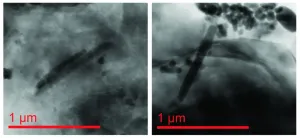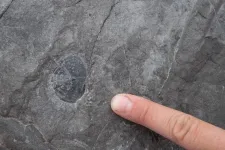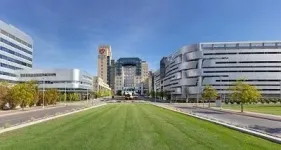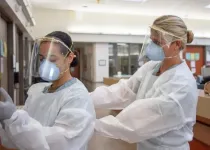(Press-News.org) There are fossils, found in ancient marine sediments and made up of no more than a few magnetic nanoparticles, that can tell us a whole lot about the climate of the past, especially episodes of abrupt global warming. Now, researchers including doctoral student Courtney Wagner and associate professor Peter Lippert from the University of Utah, have found a way to glean the valuable information in those fossils without having to crush the scarce samples into a fine powder. Their results are published in Proceedings of the National Academy of Sciences.
"It's so fun to be a part of a discovery like this, something that can be used by other researchers studying magnetofossils and intervals of planetary change," Wagner says. "This work can be used by many other scientists, within and outside our specialized community. This is very exciting and fulfilling."
The name "magnetofossil" may bring to mind images of the X-Men, but the reality is that magnetofossils are microscopic bacterial iron fossils. Some bacteria make magnetic particles 1/1000 the width of a hair that, when assembled into a chain within the cell, act like a nano-scale compass. The bacteria, called "magnetotactic bacteria," can then use this compass to align themselves to the Earth's magnetic field and travel efficiently to their favorite chemical conditions within the water.
During a few periods in the Earth's past, at the beginning and middle of the Eocene epoch from 56 to 34 million years ago, some of these biologically-produced magnets grew to "giant" sizes, about 20 times larger than typical magnetofossils, and into exotic shapes such as needles, spindles, spearheads and giant bullets. Because the bacteria used their magnetic supersense to find their preferred levels of nutrients and oxygen in the ocean water, and because the giant magnetofossils are associated with periods of rapid climate change and elevated global temperature, they can tell us a lot about the conditions of the ocean during that rapid warming, and especially how those conditions changed over time.
Previously, extraction and analysis of these fossils required crushing the samples into a fine powder for electron microscopy imaging. "The extraction process can be time-consuming and unsuccessful, electron microscopy can be costly, and the destruction of samples means that they are no longer useful for most other experiments," Wagner says. "Collection and storage of these samples require specialized personnel, equipment and planning, so we want to preserve as much material for additional studies as we can."
So Wagner, Lippert and colleagues including Ramon Egli from the Central Institute for Meteorology and Geodynamics and Ioan Lascu at the National Museum of Natural History, found another way. Using sediment samples collected in New Jersey, they designed a new way of conducting an analysis called FORC (first order reversal curve) measurements. With these high-resolution magnetic measurements, they found that the magnetic signature of giant magnetofossils was distinctive--enough that the technique could be used in other samples to identify the presence of the fossils. "FORC measurements probe the reaction of magnetic particles to externally applied magnetic fields, enabling to discriminate among different types of iron oxide particles without actually seeing them," says Egli.
"The ability to rapidly find giant magnetofossil assemblages in the geologic record will help to identify the origin of these unusual magnetofossils," the researchers write, as well as the ecology of the organisms that formed them. This is important, Wagner says, because no known living organisms form giant magnetofossils today, and we still don't know what organisms formed them in the past. "The organisms that produced these giant magnetofossils are utterly mysterious, but this leaves exciting research avenues open for the future" adds Lascu.
Beyond that, though, the information contained in magnetofossils helps scientists understand how oceans responded to past climate changes--and how our current ocean might respond to ongoing warming.
INFORMATION:
After publication, find the full study here. Although the embargo lifts on Feb. 1 at 1 p.m. Mountain/3 p.m. Eastern, the online version may publish anytime during the week of Feb. 1-5.
Most snakes get from A to B by bending their bodies into S-shapes and slithering forward headfirst. A few species, however -- found in the deserts of North America, Africa and the Middle East -- have an odder way of getting around. Known as "sidewinders," these snakes lead with their mid-sections instead of their heads, slinking sideways across loose sand.
Scientists took a microscopic look at the skin of sidewinders to see if it plays a role in their unique method of movement. They discovered that sidewinders' bellies are studded with tiny pits and have few, if any, of the tiny spikes found on the bellies of other snakes.
The Proceedings ...
CAMBRIDGE -- The temperature of a planet is linked with the diversity of life that it can support. MIT geologists have now reconstructed a timeline of the Earth's temperature during the early Paleozoic era, between 510 and 440 million years ago -- a pivotal period when animals became abundant in a previously microbe-dominated world.
In a study appearing today in the Proceedings of the National Academy of Sciences, the researchers chart dips and peaks in the global temperature during the early Paleozoic. They report that these temperature variations coincide with the planet's ...
In a new study led by Yale Cancer Center, researchers have discovered a novel metabolic gatekeeper mechanism for leukemia. This mechanism depends on a molecule called PON2, which could lead to a new treatment for the disease. The findings were published online today in the Proceedings of the National Academy of Sciences (PNAS).
B cells are effector cells of the adaptive immune system and are marked by low energy levels, which prevent transformation to leukemia. In this study, Yale scientists identified high expression levels of the detoxifying lactonase ...
Philadelphia, February 1, 2021 - Researchers at Children's Hospital of Philadelphia (CHOP) have demonstrated that autism spectrum disorder (ASD) may be caused by defects in the mitochondria of brain cells. The findings were published online by the Proceedings of the National Academy of Sciences.
Multiple studies have revealed hundreds of mutations associated with autism spectrum disorder, but there is no consensus as to how these genetic changes cause the condition. Biochemical and physiological analyses have suggested that deficiencies in mitochondria, the "batteries" of the cell that produce ...
Scientists have identified a group of drugs that may help stop a leading cause of vision loss after making an unexpected discovery that overturns a fundamental belief about DNA.
The drugs, known as Nucleoside Reverse Transcriptase Inhibitors, or NRTIs, are commonly used to treat HIV. The new discovery suggests that they may be useful against dry macular degeneration as well, even though a virus does not cause that sight-stealing condition.
A review of four different health insurance databases suggests that people taking these drugs have significantly reduced risk of developing dry macular degeneration, a condition that affects ...
A 15-year experiment on Arctic shrubs in Greenland lends new understanding to an enduring ecological puzzle: How do species with similar needs and life histories occur together at large scales while excluding each other at small scales? The answer to this question has important implications for how climate change might shift species' distributions across the globe.
The study was published today in the journal PNAS and led by the University of California, Davis. Its findings also reveal trends related to carbon sequestration and carbon exchange as the Arctic becomes both greener and browner.
EXPANSION AND EXCLUSION
Like lines of traffic traveling the same roads at the same time without crashing into each ...
CLEVELAND - Evidence suggests particulate matter is the air pollutant which poses the greatest threat to global health. Studies have shown that exposure to particulate matter smaller than 2.5 microns is associated with acute and chronic elevations in blood pressure (BP) as well as hypertension. In the study "The Benefits of Intensive Versus Standard Blood Pressure Treatment According to Fine Particulate Matter Air Pollution Exposure" published this week in the journal Hypertension, researchers at University Hospitals (UH) and Case Western Reserve University (CWRU) ...
A paper by a multidisciplinary team of scientists affiliated with various Brazilian institutions, including the University of São Paulo (USP) and the National Cancer Institute (INCA), shows that people of African descent are less likely to find a donor in the National Register of Voluntary Bone Marrow Donors (REDOME) than people with predominantly European ancestry. The paper is published in Frontiers in Immunology.
REDOME is the world’s third-largest bone marrow bank, with more than 5 million registered voluntary donors.
According to the study, having mainly African genetic ancestry can reduce a person’s chances of finding a donor by up to 60%, and having African copies of HLA genes, which must be compatible with ...
Obesity and its duration are significant risk factors for type 2 diabetes, cardiovascular events, multiple cancers and decreased quality of life. According to the Centers for Disease Control and Prevention, obesity affects 20.6% of adolescents ages 12-19 in the United States, meaning a potential lifetime of dealing with this condition. Complications from obesity can also result in a potentially decreased life expectancy of five to 20 years for these youth. In a new study published in Pediatrics, researchers at Children's Hospital Colorado (Children's Colorado) have found that both younger and older adolescents have similar weight loss, resolution of high blood pressure and high cholesterol, nutritional impacts and improvement in quality of life after bariatric surgery. These results ...
Article Title: "Game theory to enhance stock management of Personal Protective Equipment (PPE) during the COVID-19 outbreak"
Funding: The authors received no specific funding for this work.
Competing Interests: The authors have declared that no competing interests exist.
Article URL: https://journals.plos.org/plosone/article?id=10.1371/journal.pone.0246110
INFORMATION: ...








